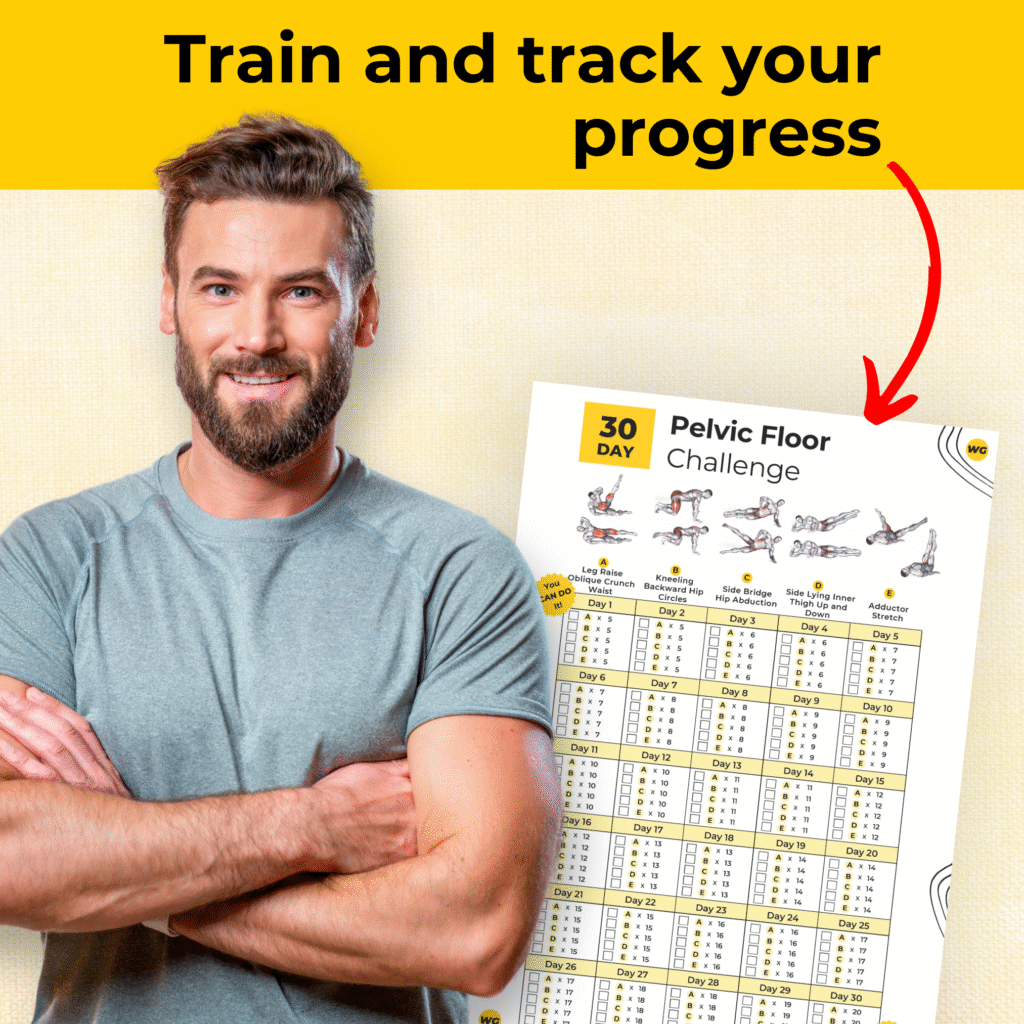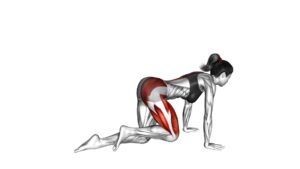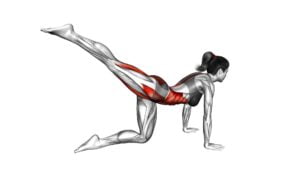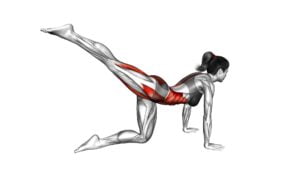Kneeling Single Kickback Fire Hydrant (male) – Video Exercise Guide & Tips

Are you looking to tone your glutes and strengthen your core? Look no further than the Kneeling Single Kickback Fire Hydrant.
Watch This Exercise Video
This exercise targets multiple muscle groups, helping you achieve a sculpted physique.
In this video exercise guide, you'll learn the proper form and technique, as well as modifications for all fitness levels.
Avoid common mistakes and get ready to take your workout routine to the next level with this effective move.
Let's get started!
Key Takeaways
- Targets multiple muscle groups including the glutes, inner and outer thighs, and adductor and abductor muscles
- Helps achieve a sculpted physique and improves muscle definition
- Enhances overall lower body strength and athletic performance
- Proper form and technique are essential to avoid common mistakes and maximize the benefits of the exercise
Benefits of the Kneeling Single Kickback Fire Hydrant
Experience the numerous benefits of the Kneeling Single Kickback Fire Hydrant exercise. This exercise is highly effective in improving glute strength and targeting the muscles of your inner and outer thighs. By incorporating this exercise into your workout routine, you can achieve a toned and sculpted lower body.
The Kneeling Single Kickback Fire Hydrant specifically engages your gluteus maximus, gluteus medius, and gluteus minimus muscles. These muscles play a crucial role in stabilizing your hips and supporting proper movement during activities such as walking, running, and squatting. Strengthening these muscles can enhance your overall athletic performance and help prevent injuries.
Additionally, this exercise also targets the muscles of your inner and outer thighs. By performing the single kickback, you engage your adductor and abductor muscles, which are responsible for hip abduction and adduction movements. Strengthening these muscles can improve your hip stability and enhance your overall lower body strength.
Now that you understand the benefits of the Kneeling Single Kickback Fire Hydrant, let's move on to the next section and learn about the proper form and technique for this exercise.
Proper Form and Technique for the Exercise
To perform the Kneeling Single Kickback Fire Hydrant exercise correctly, follow these steps:
- Start by positioning yourself on all fours, with your hands directly underneath your shoulders and your knees directly underneath your hips.
- Engage your core muscles to maintain a stable and neutral spine throughout the exercise.
- Lift your right leg out to the side, keeping your knee bent at a 90-degree angle, and your foot flexed.
- Extend your right leg straight back, while maintaining the 90-degree bend in your knee.
- Squeeze your glutes at the top of the movement, then return your right leg to the starting position.
- Repeat the exercise for the desired number of repetitions, then switch to the left leg.
Common mistakes to avoid when performing the Kneeling Single Kickback Fire Hydrant exercise include:
- Allowing your lower back to arch or sag during the movement. Keep your core engaged and your back flat.
- Raising your leg too high, which can lead to compensatory movements and decreased activation of the glutes. Focus on maintaining proper form and control.
- Rushing through the exercise. Take your time and perform each repetition with control and intention.
Variations of the Kneeling Single Kickback Fire Hydrant exercise include:
- Adding ankle weights or resistance bands to increase the intensity.
- Performing the exercise on an unstable surface, such as a stability ball or Bosu ball, to challenge your balance and stability.
- Incorporating a dumbbell or kettlebell for added resistance.
Mastering the proper form and technique of the Kneeling Single Kickback Fire Hydrant exercise will set you up for success as you progress to modifications and progressions for all fitness levels.
Modifications and Progressions for All Fitness Levels
For an added challenge and to progress your workout, consider incorporating modifications and progressions into the Kneeling Single Kickback Fire Hydrant exercise.
If you're a beginner, there are progressions you can follow to gradually build strength and improve your form. One modification you can try is reducing the range of motion by only lifting your leg slightly off the ground. This will allow you to focus on engaging your glutes and maintaining stability.
Another beginner progression is to perform the exercise without any resistance, using only your body weight. This will help you develop the necessary strength and control before adding additional resistance.
On the other hand, if you're more advanced and looking for a challenge, there are modifications you can incorporate to intensify the exercise. One advanced modification is to add ankle weights or resistance bands to increase the resistance and target your glutes even more.
Another option is to perform the exercise on an unstable surface, such as a Bosu ball or a balance pad. This will engage your core muscles and challenge your balance and stability.
Remember to always listen to your body and progress at a pace that's comfortable for you. It's important to maintain proper form and technique throughout the exercise to avoid potential injuries.
Common Mistakes to Avoid During the Exercise
To avoid common mistakes during the Kneeling Single Kickback Fire Hydrant exercise, it's important to regularly practice proper form and technique. Here are some technique tips to help you perform the exercise correctly:
- Maintain a stable core: Engage your core muscles throughout the movement to stabilize your body and prevent excessive movement.
- Use controlled movements: Avoid swinging your leg or using momentum to lift it. Instead, focus on using the muscles in your glutes and hips to perform the kickback.
- Keep your back straight: Avoid rounding or arching your lower back during the exercise. Maintain a neutral spine position to prevent strain on your back.
- Avoid lifting your leg too high: While it may be tempting to lift your leg as high as possible, it's important to avoid excessive range of motion. Lift your leg until it's parallel to the ground and no higher.
- Maintain proper alignment: Make sure your knee is directly below your hip and your foot is flexed during the kickback. This will ensure that you're targeting the correct muscles and avoiding unnecessary strain on your joints.
Tips for Incorporating the Kneeling Single Kickback Fire Hydrant Into Your Workout Routine
Incorporate the Kneeling Single Kickback Fire Hydrant into your workout routine for an effective glute and hip strengthening exercise. To make the most out of this exercise, consider incorporating resistance bands and variations for glute activation.
First, try using resistance bands during the Kneeling Single Kickback Fire Hydrant. Attach the band to your ankle and secure the other end to a sturdy anchor point. The resistance from the band will challenge your glute muscles even more, leading to increased strength and definition.
Another variation to activate your glutes is to perform the exercise on an unstable surface, such as a balance disc or a Bosu ball. This will engage your stabilizer muscles, making the exercise more challenging and effective.
To further activate your glutes, focus on squeezing them at the top of the movement. This will help to ensure that you're targeting the right muscles and maximizing the benefits of the exercise.
Incorporating the Kneeling Single Kickback Fire Hydrant into your workout routine is a great way to strengthen your glutes and hips. By adding resistance bands and trying variations for glute activation, you can take this exercise to the next level and achieve even better results.
Frequently Asked Questions
How Many Calories Does the Kneeling Single Kickback Fire Hydrant Burn?
The kneeling single kickback fire hydrant is a great exercise for lower body toning. It targets your glutes, hamstrings, and hips, helping to strengthen and tone these areas. When performed correctly, this exercise can be quite effective in burning calories and building muscle.
To properly perform the kneeling single kickback fire hydrant, start on all fours with your knees and hands on the ground. Extend one leg back, keeping it at a 90-degree angle, then return to the starting position.
Can the Kneeling Single Kickback Fire Hydrant Help Improve Balance and Stability?
The kneeling single kickback fire hydrant is a great exercise for improving balance and stability. By incorporating this exercise into your routine, you can enhance your coordination and increase flexibility.
It targets multiple muscle groups, including the glutes, hamstrings, and core, helping to strengthen and stabilize your body. Adding this exercise to your workouts can be beneficial for overall fitness and can contribute to improved balance and stability in daily activities.
Is the Kneeling Single Kickback Fire Hydrant Suitable for People With Knee Injuries?
If you have knee injuries, you may be wondering if the kneeling single kickback fire hydrant exercise is suitable for you. The kneeling single kickback fire hydrant can put strain on the knees, so it's important to be cautious.
Modifications can be made to reduce the impact on your knees, such as using a softer surface or placing a cushion under your knees.
Always consult with a healthcare professional before attempting any exercise if you have knee injuries.
How Often Should the Kneeling Single Kickback Fire Hydrant Be Performed for Optimal Results?
To achieve optimal results with the kneeling single kickback fire hydrant, it's important to consider the frequency of the exercise.
By performing this exercise regularly, you can maximize its benefits. Incorporating it into your workout routine two to three times a week can help strengthen your glutes, hamstrings, and core muscles.
Remember to listen to your body and gradually increase the intensity as you progress.
Can the Kneeling Single Kickback Fire Hydrant Help in Strengthening the Core Muscles?
Yes, the kneeling single kickback fire hydrant can help in strengthening your core muscles. By engaging your glute muscles and stabilizing your body during the exercise, you're also working your core.
Kneeling exercises, like this one, offer several benefits such as targeting multiple muscle groups, improving balance, and increasing overall strength. Incorporating this exercise into your routine can be an effective way to strengthen your core and achieve optimal results.
Conclusion
Incorporating the kneeling single kickback fire hydrant into your workout routine can offer numerous benefits.
This exercise targets your glutes and hamstrings, helping to strengthen and tone these muscles.
By maintaining proper form and technique, you can maximize the effectiveness of the exercise.
Remember to start with modifications or progressions that suit your fitness level and avoid common mistakes.
Including this exercise in your routine can enhance your lower body strength and overall fitness.

Author
Years ago, the spark of my life’s passion ignited in my mind the moment I stepped into the local gym for the first time. The inaugural bead of perspiration, the initial endeavor, the very first surge of endorphins, and a sense of pride that washed over me post-workout marked the beginning of my deep-seated interest in strength sports, fitness, and sports nutrition. This very curiosity blossomed rapidly into a profound fascination, propelling me to earn a Master’s degree in Physical Education from the Academy of Physical Education in Krakow, followed by a Sports Manager diploma from the Jagiellonian University. My journey of growth led me to gain more specialized qualifications, such as being a certified personal trainer with a focus on sports dietetics, a lifeguard, and an instructor for wellness and corrective gymnastics. Theoretical knowledge paired seamlessly with practical experience, reinforcing my belief that the transformation of individuals under my guidance was also a reflection of my personal growth. This belief holds true even today. Each day, I strive to push the boundaries and explore new realms. These realms gently elevate me to greater heights. The unique combination of passion for my field and the continuous quest for growth fuels my drive to break new ground.







